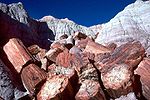Paleobotany
Paleobotany is the field of paleontology involved with the study of ancient plants. It is an important area of creation biology, as creationism and evolutionism have radically different descriptions of ancient plant life. Creationism holds that a wide variety of plant life was created by God fully intact with the capacity to reproduce and adapt to changing environments, approximately 6,000 years ago. Evolutionism holds that all plant life (and indeed all life on the planet) is related by common descent over millions of years, and that more complex plants developed more recently than simpler plants.
Petrified Wood
- Main Article: Petrified wood
One of the most abundant fossils in the world is undoubtedly petrified wood. In many parts of the world entire forests can be found lying about with little sign of decomposition.
Rapid coal formation
- Main Article: Rapid coal formation
The physical evidence of the coal beds strongly favors the theory that the plant accumulations had been washed into place. The coal seams are almost universally found in stratified deposits. The non-carbonaceous sediments intervening between the coal seams are always said to have been water-borne and deposited. The great thickness of some seams and the great numbers of seams in a given locality also constitute prima facie evidence of rapid and cyclic currents carrying and depositing heavy burdens of organic material.
Precambrian pollen
In the 1980's, the Creation Research Society repeated and confirmed the earlier research of Clifford Burdick, finding intact pollen in the PreCambrian strata of the Grand Canyon, which according to standard chronology should have had no flowering plants.
- Creation Research Society Studies on Precambrian Pollen: Part I - A Review by George Howe, Ph.D. 1986 CRSQ 23(3):99 - 104. This paper analyzes claims that Clifford Burdick's findings at the Grand Canyon were the result of contamination.
- Creation Research Society Studies On Precambrian Pollen - Part II: Experiments On Atmospheric Contamination Of Microscope Slides by Walter Lammerts, Ph.D. and George Howe, Ph.D. 1987. CRSQ 23(4):151-153. This paper analyzes claims that Clifford Burdick's findings at the Grand Canyon were the result of contamination.
- Creation Research Society Studies On Precambrian Pollen - Part III: A Pollen Analysis Of Hakatia shale And Other Grand Canyon Rocks by Ph.Ds George Howe, Emmet Williams, George Matkzo and Walter Lammerts 1988. CRSQ 24(4):173 - 182. This paper analyzes claims that Clifford Burdick's findings at the Grand Canyon were the result of contamination.
Dendrochronology

- Main Article: Dendrochronology
Dendrochronology is a technique of dating past climatic changes through a study of tree ring growth. Each year a tree adds a layer of wood to its trunk and branches thus creating the annual rings we see when viewing a cross section. Wide rings are produced during wet years and, narrow rings during dry seasons.
References
- More Creationist Research, PART II: BIOLOGICAL RESEARCH, Variable Production of Growth Rings in Bristlecone Pinesby Duane T. Gish, Ph.D., Creation Research Society Quarterly 26(1):5 June, 1989
See Also
| |||||||||||||||||


